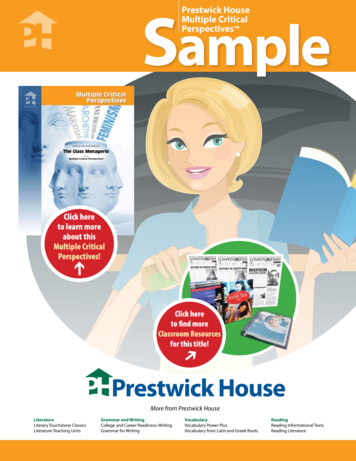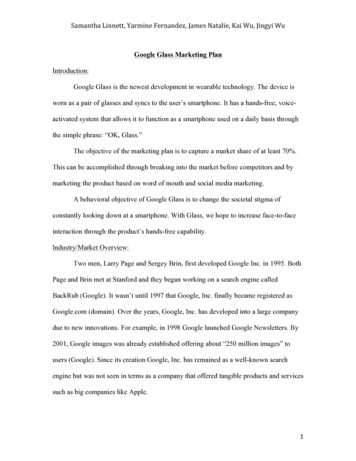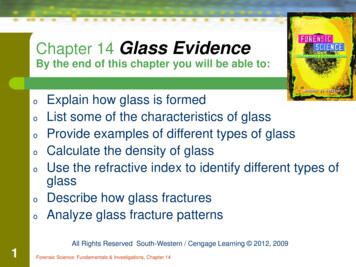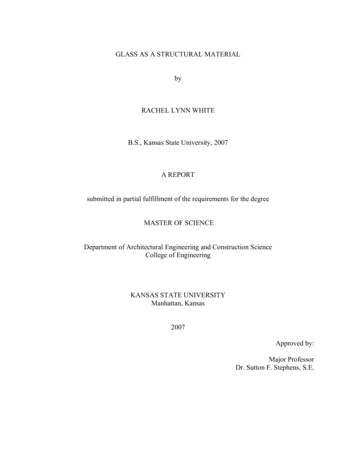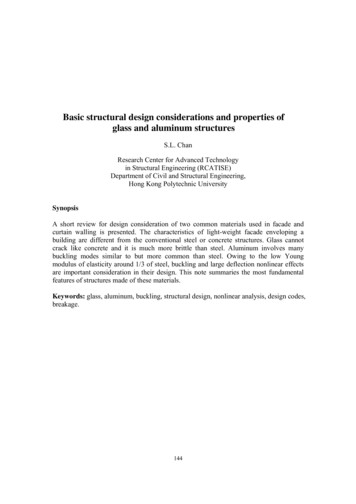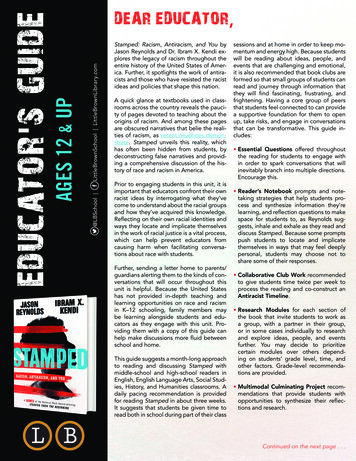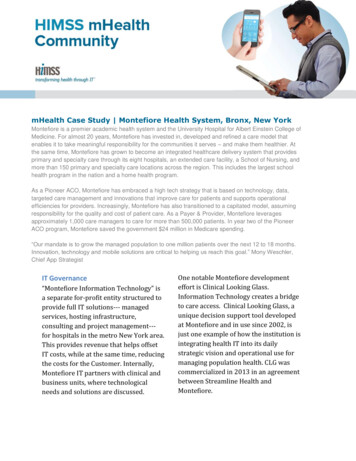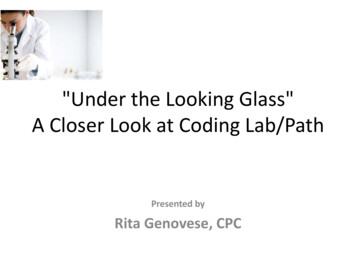
Transcription
"Under the Looking Glass"A Closer Look at Coding Lab/PathPresented byRita Genovese, CPC
Agenda Lab/Path Testing CategoriesCoding Tips2013 Code Changes – At a GlanceDiagnostic CodingLab Fee ScheduleNational Correct Coding Initiative– Modifiers Discussion
Laboratory/Pathology Testing Categories of Testing1. Screening No established diagnosis No signs or symptoms2. Diagnosing There are signs and symptoms3. Monitoring There is a diagnosis There is a treatment, care plan or medication
Path/Lab Coding Tips CPT codes - 80000 series Important terminology needed for codeselection:– Specimen, Method, Total or Free– Manual or automated– Qualitative or Quantitative– Initial– Antibody vs. Antigen codes series
Path/Lab Coding Tips When more than one code is needed:– Charge explosions refers to a series or bundles of codes that can beinvoked through a single line item charge. In lieu of entering all of the individual codes , one codemay be used that then “explodes” into the list of codes– Commonly used for Panels , Profiles and Reflex Tests When there isn’t a code– Be careful when using unlisted procedure codes– Use testing method codes
2013 Code Changes LOTS!!! Guideline changes– Evocative/Suppression testing– Molecular Pathology– Chemistry Definitions clarifications/updates nsfusion MedicineTier 1: 13 new codesTier 2: represents medically useful procedures performed inlower volumes than Tier 1
2013 Code Changes Code additions– Chemistry– Immunology– Tissue typing– Microbiology– Cytopathology– Surgical Pathology– Molecular Pathology
2013 Code Changes - Chemistry 82009-82010 were updated to reflect currenttechniques with example tests 82777 added to report Galectin-3
2013 Code Changes - Immunology 86152-86153 were created to reportcirculating tumor cell testing (CTC),interpretation and reporting(Replace Category III codes previouslyreported by 0278T and 0280T) 86711 added to report JC virus testing
Tissue Typing 86828-86835 were created to report HLAtesting
2013 Code Changes - Microbiology 87910 added to report nucleic acid probetechnique for detection of cytomegalovirus 87912 added to report nucleic acid detectionof Hepatitis B virus 87631-87633, 87910, 87912 – Infectious agentdetection by nucleic acid
Cytopathology 88184-88189– Should only be used to report the detection ofmarkers as used in the assessment of hematologicconditions
Surgical Pathology 88375– For interpretation and reporting of opticalendomicroscopic images
Molecular Pathology 60452-26 used by pathologists when aninterpretation of a molecular pathology test isperformed– replacing: 83912-26
Molecular Pathology 8116181201, 812038123581252-8125481321- 8132681400-81408Unlisted Molecular Biology Procedure: 81479
Multianalyte Assays (MAAA) 81500 – ROMA 81503 – OVA 1 81599 – Maternal Serum Screening
Deleted Codes 83890-83914– Molecular pathology codes 88384-88386– Assay-based evaluation codes
Revised Codes 81400 Molecular Path Procedure Level 181401 FGFR381402 Molecular Path Procedure Level 381403 Molecular Path Procedure Level 482009 Ketone Body Qualitative86891 Intra- or post-operative salvage
Revised Codes 87498 Enterovirus amplified probe technique87521 Hep C amplified probe technique87522 Hep C quantifications87535-87536 HIV 187538-87539 HIV 2
Diagnostic Services ICD-9 coding– Sequencing: DiagnosisConditionProblemOther (reason for encounter/ visit) Other diagnoses may be sequenced asadditional diagnoses
Diagnostic ServicesICD-9 coding:– When patients receive only diagnostic servicesduring an encounter, the appropriate V code forthe examination is sequenced first– The diagnosis/problem for which the services arebeing performed is sequenced second
Diagnostic ServicesICD-9 coding For routine lab testing, with no signs,symptoms, or associated diagnosis, use:– V72.60, V72.61, V72.62– Be sure to pay attention to the “includes” and“excludes” in the appropriate V codes, as this mayimpact the final diagnosis used for billingpurposes
Diagnostic Services V72.6x– used to describe the reason for the encounter(e.g. study biopsy specimen) If there’s an established diagnosis, anadditional code should be submitted for thediagnosis
Diagnostic Services If routine testing is performed at the sameencounter as a test to evaluate a sign,symptom, or diagnosis, it is appropriate toassign both the V code and the codedescribing the reason for the non-routinetest.
Diagnostic Services – Pro Fee For outpatient encounters for diagnostic teststhat have been interpreted by a physician, andthe final report is available at the time ofcoding– code any confirmed or definitive diagnosis(es)documented in the interpretation Do not code related signs and symptoms asadditional diagnoses
CMS Clinical Lab Fee Schedule
CMS Clinical Lab Fee Schedule2013 Clinical Diagnostic LaboratoryFee itPointLoc 00Loc 00Loc 00Loc 00Loc 0036415 0.00 3.00 3.00 3.00 3.00 3.00 3.0078267 10.81 14.61 10.81 10.81 10.81 10.81 10.8178268 92.59 125.12 92.59 92.59 92.59 92.59 92.5980047 11.63 15.71 11.63 11.63 11.63 11.63 11.63 11.63 15.71 11.63 11.63 11.63 11.63 11.63 11.63 15.71 11.63 11.63 11.63 11.63 11.63 11.63 15.71 11.63 11.63 11.63 11.63 11.63 9.64 13.03 9.64 9.64 9.64 9.64 9.64 9.64 13.03 9.64 9.64 9.64 9.64 9.64 14.53 19.63 14.53 14.53 14.53 14.53 14.53 14.53 19.63 14.53 14.53 14.53 14.53 005380053QW
National Correct Coding Initiative(NCCI) – Modifier 59 Modifier -59 is used (to identify):– procedures/services that are not normally reportedtogether, but are appropriate under certain circumstances– designate instances when distinct and separate multipleservices are provided to a patient on a single date ofservice– separate sessions or patient encounters, or differentprocedures– if the same procedure using the same procedure code isused for testing a different specimen (e.g. aerobic cultureof two independent wound site specimens)
NCCI - Modifier 59 Modifier -59 is NOT used when a test is orderedand performed and additional related proceduresare necessary to provide or confirm the result– These additional tests are considered part of theordered test Example – A patient has an abnormal test resultand the Pathologist repeat s the test to verify theresult
Modifier -90 Reference Laboratory When laboratory procedures are performedby a party other than the treating or reportingphysician, the procedure may be identified byadding modifier -90 to the usual procedurenumber
NCCI - Modifier 91Repeat Clinical Diagnostic Test Modifier -91 is used to identify repeat performanceof the same laboratory test on the same day toobtain subsequent (multiple) test results– Example: If a second culture was performed fromthe same site on the same day
NCCI - Modifier 91 Modifier -91 is NOT used when tests are rerun to confirm initial results due to testingproblems when a normal, one-timereportable result is all that is required
Discussion
National Correct Coding Initiative (NCCI) - Modifier 59 Modifier -59 is used (to identify): -procedures/services that are not normally reported together, but are appropriate under certain circumstances -designate instances when distinct and separate multiple services are provided to a patient on a single date of service

